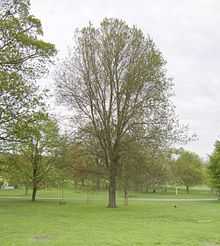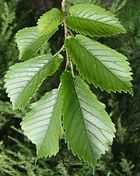Ulmus 'Groeneveld'
| Ulmus hybrid | |
|---|---|
 'Groeneveld'
Stanmer Park, Brighton, UK | |
| Hybrid parentage | U. × hollandica × U. minor |
| Cultivar | 'Groeneveld' |
| Origin | Netherlands |
Ulmus 'Groeneveld' was cloned in 1949 and released in 1963 in response to the earlier, less virulent form of Dutch elm disease that afflicted Europe shortly after the First World War.[1][2] The cultivar was derived from a crossing of Dutch clones '49', (originally believed to be an English Wych Elm Ulmus glabra but later identified as another example of Ulmus × hollandica) and '1', a Field Elm Ulmus minor found in central France and marketed by the Barbier nursery in Orléans.
Description

The tree is slow growing, and produces a dense, upswept growth which initially made it popular as a street tree in the Netherlands.[3] The obovate leaves are < 9 cm long by 4 cm broad, arranged in clusters on short branchlets.[4]
Pests and diseases
'Groeneveld' has good resistance to Coral-spot fungus Nectria cinnabarina, and Black Spot . However, like all the other Dutch hybrids released before 1989, it proved to have only marginal resistance, rated 3 out of 5 [5] to the later, virulent form of Dutch elm disease and consequently planting is no longer recommended where the disease is prevalent.[6][7]
Cultivation
'Groeneveld' was also introduced elsewhere in Europe, including Britain, in small numbers. The tree was planted in trials in Canberra, Australia started in 1988, but has not shown promise in that environment so far; it has however proved popular in New Zealand. There are several specimens in American arboreta (see under Accessions).
Notable trees
The TROBI Champion tree in the UK is at Stanmer Park, near Brighton, East Sussex, measuring 18 m high by 53 cm d.b.h. in 2002[8]
Hybrid cultivars
- FL 522: derived from a crossing with the Chinese species Ulmus chenmoui by the Istituto per la Protezione delle Piante in Florence. There are no plans (2009) to release it to commerce.
Accessions
North America
- Holden Arboretum. Acc. no. 70-127
- Morton Arboretum. Acc. no. 76-72, 29-2007 (graft).
Europe
- Brighton & Hove City Council, UK, NCCPG Elm Collection , UK champion: Stanmer Park, 18 m high, 53 cm d.b.h. in 2002.[8]
- Grange Farm Arboretum , Sutton St. James, Spalding, Lincs., UK. Acc. no. 830.
- Royal Botanic Garden Wakehurst Place. Acc. no. 1975-6125
- Sir Harold Hillier Gardens. Acc. no. 1977.6442
Nurseries
Europe
- Bellwood Trees, Meigle, Perthshire, Scotland, UK.
- De Reebock , Zwalm, Belgium.
- Noordplant , Glimmen, The Netherlands.
- Westerveld Boomkwekerij B.V., Opheusden, Netherlands.
Australasia
References
- ↑ Burdekin, D. A. & Rushforth, K. D. (Revised by Webber J. F. 1996). Elms resistant to Dutch elm disease. Arboricultural Research Note 2/96. Arboricultural Advisory and Information Service, Alice Holt, Farnham, UK.
- ↑ Santamour, F. S., & Bentz, S. E. (1995). Updated checklist of elm (Ulmus) cultivars for use in North America. Journal of Arboriculture, 21(3): May, 1995.
- ↑ White, J. & More, D. (2002). Trees of Britain & Northern Europe. Cassell's, London.
- ↑ Photographs of 'Groeneveld' elm and samarae
- ↑ Heybroek, H. M., Goudzwaard, L, Kaljee, H. (2009). Iep of olm, karakterboom van de Lage Landen (:Elm, a tree with character of the Low Countries). KNNV, Uitgeverij. ISBN 9789050112819
- ↑ Heybroek, H. M. (1964). Plant Disease Rep. 48: 187-189, 1964, transl. by F. W. Holmes.
- ↑ Heybroek, H. M. (1993). The Dutch Elm Breeding Program. In Sticklen & Sherald (Eds.) (1993). Dutch Elm Disease Research, Chapter 3. Springer Verlag, New York, USA
- ↑ 8.0 8.1 Johnson, O. (2011). Champion Trees of Britain & Ireland, p. 169. Kew Publishing, Kew, London. ISBN 9781842464526.